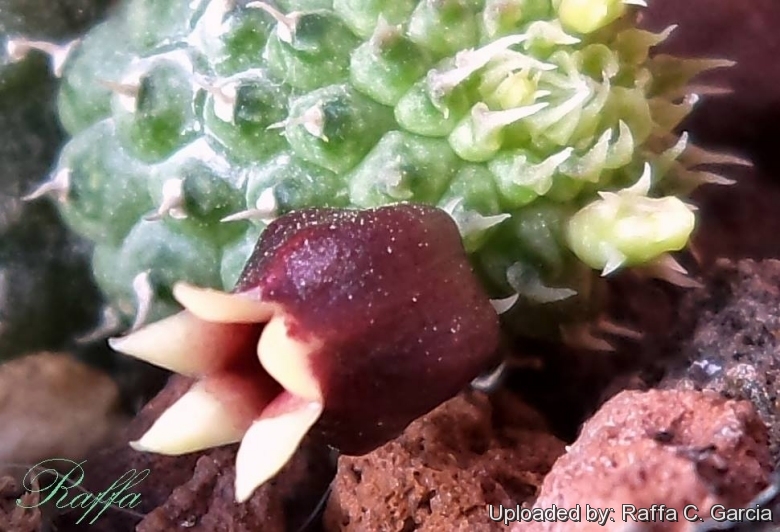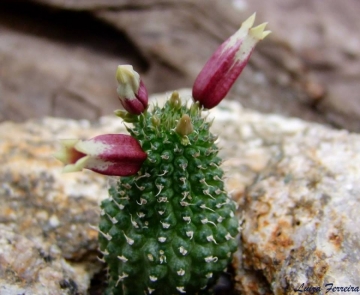
Echidnopsis urceolata Photo by: Raffa C. Garcia
Origin and Habitat: Echidnopsis urceolataSN|30338]]SN|30338]] is found in the Mandera district of the north-east corner of Kenya and in the Ogaden area of Harerge Region of Ethiopia.
Altitude range: 400–700 metres above sea level.
Synonyms:
See all synonyms of Echidnopsis urceolata
back
Accepted name in llifle Database:Echidnopsis urceolata P.R.O.BallyCandollea 18: 342 1963Synonymy: 4
back
Description: Echidnopsis urceolataSN|30338]]SN|30338]] is a distinct perennial succulent plant with its tiny urceolate (urn- shaped) or tubular flowers. Its growth-form resembles a small, thorny Trichocaulon, but, regarding the flower structure, it must be placed in the genus Echidnopsis. The flowers of E. urceolata are extremely variable in size and shape.
Stems: Single or branching at the base, cylindrical, erect, prostrate-decumbent or procumbent, 12–20-angled, 20–70(-90) mm long, 20–25 mm thick, covered densely with conical tubercles.
Leaves: Lanceolate, up to 3.5 mm long, rapidly drying off and persistent as hard white bristles.
Flowers: On 1–1.5 mm long pedicels. Sepals lanceolate 1.5-3 mm long, 0.7-1.5mm wide at base, tips often recurved. Corolla urn-shaped to long tubular, (5-)9-18 mm long, tube 6–7 mm wide at base, gradually constricted at mouth to 3-4 mm, outside purple-red towards base and pale yellow upwards, inside purple red, glabrous deeply pentagonal in cross-section; lobes triangular with slightly recurved tip, 1–3 mm long, greenish yellow. Corona cup-shaped, rounded-pentagonal with minutely emarginate rim; inner lobes long, triangular, connivent over the staminal column.
Chromosome number: 2n = 22.
Bibliography: Major references and further lectures
1) M. Gilbert, D. Goyder, J. Lavranos, S. Liede-Schumann, M. Thulin, and J. Venter. “Flora Somalia” Vol 3, (2006) [updated by M. Thulin 2008]
2) Focke Albers, Ulrich Meve “Illustrated Handbook of Succulent Plants: Asclepiadaceae: Asclepiadaceae” Volume 4 Springer Science & Business Media, 2002
3) Werner Rauh “The Wonderful World of Succulents: Cultivation and Description of Selected Succulent Plants Other Than Cacti” Smithsonian Institution Press, 1984
4) Mauro Grabiele, Ana I. Honfi & Julio R. Daviña. “IAPT/IOPB chromosome data 10” Edited by Karol Marhold in TAXON 59 (6) • December 2010: 1934–1938
5) Echidnopsis urceolata in: Bradleya 6: 1988
 Echidnopsis urceolata Photo by: Luiza Ferreira
Echidnopsis urceolata Photo by: Luiza FerreiraSend a photo of this plant.The gallery now contains thousands of pictures, however it is possible to do even more. We are, of course, seeking photos of species not yet shown in the gallery but not only that, we are also looking for better pictures than those already present.
Read More... Cultivation and Propagation: Echidnopsis urceolataSN|30338]]SN|30338]] is an easy obliging blooming plant, which is happy in any average succulent house.
Soil: Since roots are quite shallow, use a cactus mix or add extra perlite or pumice to regular soil potting soil. A gritty, very free-draining compost is suitable, and clay pots help the plants to dry out between watering.
Watering: They require moderately watering through the growing season but enjoy plenty of water and some fertiliser in hot weather, this helps them to flower freely. Water more sparingly in winter according to temperatures. But, as with most asclepiads, it is unwise to leave them wet in cold weather.
Hardiness: Winter care presents no problems at 10°C with plenty of light.
Sun Exposure: Partial sun or light shade.
Pest and diseases: They are generally fairly easy to grow, especially if kept pest-free. They are susceptible to stem and root mealy bugs, and damage from these may well initiate fungal attack. If you do have problems with a stem or with basal rotting, you can reliably isolate the healthy parts, dry them off, and re-root them in moist compost.
Cultural Practices: Re-pot every 2 years.
Propagation: Easiest with stem cuttings. Allow cuttings to dry a day before planting. Stems must be laid (Not buried) on gritty compost and will then root from the underside of the stems. It can also be increased from seeds sowing in spring in moist, sandy peat moss. Barely cover seeds.












